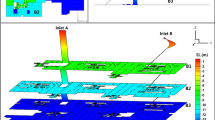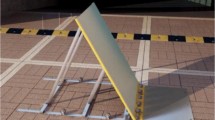Abstract
Underground space in urban areas has been expanding rapidly during recent decades, and so has the incidence of fatal accidents and extensive damage to facilities resulting from underground flooding. To evaluate the safe evacuation potential of individual underground spaces in flood-prone urban areas, the hydraulic effects of flood prevention measures, e.g., stacked flashboards or sandbags and elevated steps, were incorporated in a proposed formula for estimating the depth of inundation of an underground floor. A mathematical expression of the critical rainfall intensity for safe evacuation from underground space was established and then evaluated for two types of underground spaces, an underground shopping mall and a building basement. The results show that the critical rainfall intensity for any individual underground space can be determined easily using the proposed analytical or graphical solution. However, traditional underground flood prevention measures cannot improve safety if people refuse to evacuate immediately once water intrudes into the underground space.
Similar content being viewed by others
References
Abt, S.R., Wittler, R.J., Taylor, A., Love, D.J., 1989. Human stability in a high flood hazard zone. Water Research Bulletin, AWRA, 25(4):881–890.
Bobylev, N., 2007. Sustainability and Vulnerability Analysis of Critical Underground Infrastructure. In: Linkov, I., Wenning, R.J., Kiker, G.A. (Eds.), Managing Critical Infrastructure Risks: Decision Tools and Applications for Port Security, Springer, p.445–469. [doi:10.1007/978-1-4020-6385-5_26]
Bobylev, N., 2009. Mainstreaming sustainable development into a city’s Master plan: A case of Urban Underground Space use. Land Use Policy, 26(4):1128–1137. [doi:10.1016/j.landusepol.2009.02.003]
CCIDUS (Committee of Countermeasures against Inundation Disasters in Underground Spaces), 2002. Guideline for Measures against Inundation of Underground Spaces. Ministry of Land, Infrastructure, Transport and Tourism (MLIT), Japan (in Japanese).
Evans, D., Stephenson, M., Shaw, R., 2009. The present and future use of ‘land’ below ground. Land Use Policy, 26(S1):302–316. [doi:10.1016/j.landusepol.2009.09.015]
GB 50014-2006. Shanghai Municipal Engineering Design General Institute (SMEDI). Code for Design of Outdoor Wastewater Engineering. National Standard of the People’s Republic of China. China Planning Press, Beijing (in Chinese).
Greater London Authority, 2005. Climate Change and London’s Transport Systems-Summary Report. Available from http://www.london.gov.uk/lccp/publications/transport.jsp [Accessed on Mar. 10, 2009].
Inoue, K., Toda, K., Nakai, T., Takemura, N., Oyagi, R., 2003. On the inundation process in the underground space. Annuals of Disaster Prevention Research Institute, Kyoto University, 46B:263–273 (in Japanese).
Ishigaki, T., Toda, K., Baba, Y., Inoue, K., Nakagawa, H., Yoshida, Y., Tagawa, H., 2005. Experimental study on evacuation from underground space by using real size models. Annuals of Disaster Prevention Research Institute, Kyoto University, 48B:639–646 (in Japanese).
Ishikawa, Y., Morikawa, H., Iida, M., 2002. Flood Forecasting and Management of Underground Spaces. In: Strecker, E.W., Huber, W.C. (Eds.), Global Solutions for Urban Drainage (CDROM). American Society of Civil Engineers. [doi:10.1061/40644(2002)269]
Kaneki, M., 2003. Minimization of Flood Disasters in Urban Areas. In: National Institute for Land and Infrastructure Management Ministry of Land, Infrastructure and Transport, Annual Report of NILIM, Tokyo, p.14–19.
Kawata, Y., Goto, R., Matsuo, I., 2003. A study on inundation disasters in the underground space in Japan and their countermeasures (1). Annuals of Disaster Prevention Research Institute, Kyoto University, 46B:919–928 (in Japanese).
Oertel, M., Schlenkhoff, A., 2008a. Flooding of Underground Facilities in Urban Regions. 4th International Conference on Flood Defense, Toronto, Canada.
Oertel, M., Schlenkhoff, A., 2008b. Flood Wave Propagation and Flooding of Underground Facilities. River Flow, International Conference on Fluvial Hydraulics. Izmir, Turkey.
Pu, W.Q., 2008. Flood prevention and countermeasures for urban underground space. Port & Waterway Engineering, (10):223–228, 233 (in Chinese).
RESCDAM, 2000. The Use of Physical Models in Dam-break Flood Analysis. Research Report, Helsinki University of Technology, Finland.
Sander, E.G., 2007. Storm Report. Metropolitan Transportation Authority, London, UK.
Takasaki, H., Chikahisa, H., Yuasa, Y., 2000. Planning and mapping of subsurface space in Japan. Tunnelling and Underground Space Technology, 15(3):287–301. [doi:10.1016/S0886-7798(00)00057-2]
Teng, W.H., Hsu, M.H., Wu, C.H., Chen, A.S., 2006. Impact of flood disasters on Taiwan in the last quarter century. Natural Hazards, 37(1–2):191–207. [doi:10.1007/s11069-005-4667-7]
Toda, K., 2007. Urban flooding and measures. Journal of Disaster Research, 2(3):143–144.
Wang, J.H., Koizumi, A., Liu, X., 2008. Advancing sustainable urban development in China. Proceedings of the Institution of Civil Engineers: Municipal Engineer, 161(1):3–10. [doi:10.1680/muen.2008.161.1.3]
Author information
Authors and Affiliations
Corresponding author
Additional information
Project (No. 2009QNA4024) supported by the Fundamental Research Funds for the Central Universities, China
Rights and permissions
About this article
Cite this article
Shao, Wy. Critical rainfall intensity for safe evacuation from underground spaces with flood prevention measures. J. Zhejiang Univ. Sci. A 11, 668–676 (2010). https://doi.org/10.1631/jzus.A1000137
Received:
Accepted:
Published:
Issue Date:
DOI: https://doi.org/10.1631/jzus.A1000137




